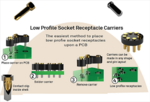Introduction:
Reducing height and space is always a goal in new product design. Reducing module space translates into cost savings. For rackmount assemblies, space is limited between printed circuit boards. Low-profile carriers eliminate permanent onboard insulators minimizing socket height. This allows engineers to use sockets in their designs without the added height of a socket insulator.
A benefit of socketing a device is it allows for solderless replacement and upgrade in the field.
A socket carrier is a hybrid assembly consisting of a pinned carrier insulator and loose receptacles mounted onto those pins. Unlike a standard molded socket, the carrier insulator does not remain on the board after soldering. It is lifted off and disposed of.
Carriers are an assembly method for placing a field of loose receptacles onto a PCB without leaving an attached permanent insulator.
Without an insulator to obstruct the view, topside PCB cleaning and solder joint inspection becomes easy.
Carriers can be packaged in standard industry configurations or made from custom patterns.
Through-hole receptacle carriers are typically hand placed onto a PCB.
A carrier can be designed for pick and place. However, it will require precision placement into the through-hole pattern.
Carriers are hybrid assemblies, and as such, can be populated with multiple size socket receptacles. An example is a socket carrier for a power brick. High current sockets with large diameter pins will have one size receptacle, and low current signal pins with small diameters will be populated with smaller diameter sockets.
A surface mount carrier may be problematic because the receptacles are friction fit onto the male carrier pins, and not in a fixed position. This may result in coplanarity issues. Perhaps if the carrier is fixtured in place on the PCB during soldering this can be overcome.
Carriers can place receptacles for pin-in-paste or wave soldering assembly. For pin-in-paste, solder paste is applied on the top surface and reflowed.
Be careful with the selection of the carrier pin, if the pin is too large it may stretch out the internal fingers which will cause losing the lower acceptance range of the socket.
If care is taken in the handling of the carriers, they may be eligible for a recycling discount, but the acceptance criteria it is up to the manufacturer.
If carefully planned, the carrier insulator can also serve a function. For example: as a module cover or board spacer.
Pin carriers exist too. Pin fields can be placed by using a removable Kapton carrier. A groove feature allows pins to snap and retain onto the Kapton carrier.
Summary:
Socket carriers are a convenient approach to placing fields of loose receptacles onto a printed circuit board without an insulator. Typically, product designers use socket carriers when they need the lowest available socket profile. Low-profile receptacles only have an exposed shoulder above the printed circuit board.
Comments and suggestions are welcome.


Reducing height and space is always a goal in new product design. Reducing module space translates into cost savings. For rackmount assemblies, space is limited between printed circuit boards. Low-profile carriers eliminate permanent onboard insulators minimizing socket height. This allows engineers to use sockets in their designs without the added height of a socket insulator.
A benefit of socketing a device is it allows for solderless replacement and upgrade in the field.
A socket carrier is a hybrid assembly consisting of a pinned carrier insulator and loose receptacles mounted onto those pins. Unlike a standard molded socket, the carrier insulator does not remain on the board after soldering. It is lifted off and disposed of.
Carriers are an assembly method for placing a field of loose receptacles onto a PCB without leaving an attached permanent insulator.
Without an insulator to obstruct the view, topside PCB cleaning and solder joint inspection becomes easy.
Carriers can be packaged in standard industry configurations or made from custom patterns.
Through-hole receptacle carriers are typically hand placed onto a PCB.
A carrier can be designed for pick and place. However, it will require precision placement into the through-hole pattern.
Carriers are hybrid assemblies, and as such, can be populated with multiple size socket receptacles. An example is a socket carrier for a power brick. High current sockets with large diameter pins will have one size receptacle, and low current signal pins with small diameters will be populated with smaller diameter sockets.
A surface mount carrier may be problematic because the receptacles are friction fit onto the male carrier pins, and not in a fixed position. This may result in coplanarity issues. Perhaps if the carrier is fixtured in place on the PCB during soldering this can be overcome.
Carriers can place receptacles for pin-in-paste or wave soldering assembly. For pin-in-paste, solder paste is applied on the top surface and reflowed.
Be careful with the selection of the carrier pin, if the pin is too large it may stretch out the internal fingers which will cause losing the lower acceptance range of the socket.
If care is taken in the handling of the carriers, they may be eligible for a recycling discount, but the acceptance criteria it is up to the manufacturer.
If carefully planned, the carrier insulator can also serve a function. For example: as a module cover or board spacer.
Pin carriers exist too. Pin fields can be placed by using a removable Kapton carrier. A groove feature allows pins to snap and retain onto the Kapton carrier.
Summary:
Socket carriers are a convenient approach to placing fields of loose receptacles onto a printed circuit board without an insulator. Typically, product designers use socket carriers when they need the lowest available socket profile. Low-profile receptacles only have an exposed shoulder above the printed circuit board.
Comments and suggestions are welcome.
